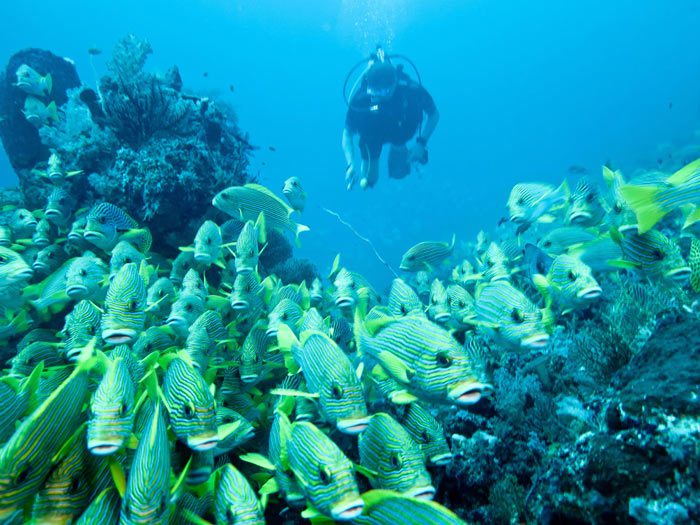
Hammerhead sharks
Do you remember our first meeting? This indelible memory, this magical moment when time stops, this memory for which you have never forgotten any details?
For me, this was my first meeting with a Manta ray in Komodo, on Kurang Makassar. A big male, who stopped in front of us, less than 5 meters away and looked at us in the eyes. A moment of grace! And for you, what’s your magical moment?
For Audrey, Jakaré cruise manager, her moment of grace was her first encounter with a hammerhead shark:
« It happened during my first dive on the island of Nusa Laut in Ambon. Sometimes we can see hammerhead sharks on Tanjung Amed dive site but not that often. We went in the water, the three guests I was guiding and I. In the middle of our diving session, we flew over an underwater sand ridge. This one can reach down 40-45 meters. We could not see much, then I turned around, and here she was, in front of me, facing me. She was so close that I could see here little eyes. She was beautiful, elegant and her movements did not have any sudden gestures that other shark species can have.
She was so beautiful; I fell in love at first sight.
Then, she slided between me and the guests and went away, like that!
It is crazy because from her profile, she could have been a grey shark and, when she turned to face me, my heart bumped in my chest. »
Hammerhead sharks
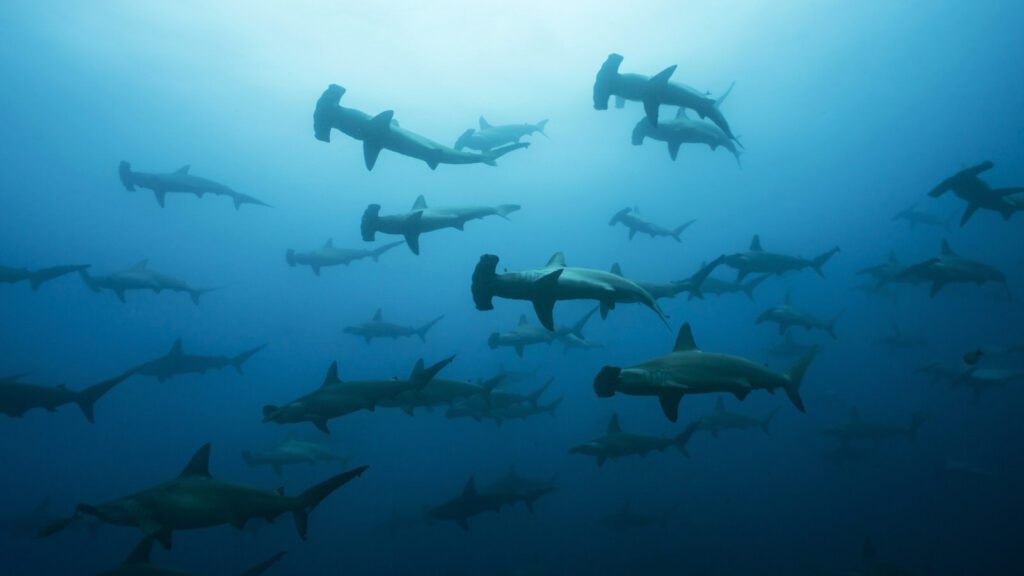
Hammerhead sharks
There are nine referenced hammerhead shark species in the world.
In Banda, only one type can be seen: the Halicorne hammerhead shark (Sphyrna lewini) who is unfortunately an endangered species.
The Halicorne females migrate from the southern to the northern hemisphere to meet males and breed. Today there are still lots of unknown regarding this migration.
Scientists may have a hypothesis about the place where the breeding happens but, if it is the case it is kept as a secret in order to preserve the species.
In the Banda Sea, we can admire the females who swim back to the North Hemisphere. Their trip can last a few months including a month and a half in Banda.
The main school of sharks counts more than 200 individuals. This is unique because the Halicorne is known to be a solitary or live within small schools.
In the main school of sharks, groups separate to go playing and hunting in the thermocline. These groups we can encounter are from ten to fifteen sharks but, if you are lucky enough, it can be groups of about fifty individuals.
The smaller groups do not move too far from the main school which swims in deeper waters and more in the big blue.
There are strict rules inside the groups, like for example, the leader is the one who stays in the middle of the group. We can notice it because it is the biggest shark.
To see hammerhead sharks while diving, you need to follow precise rules:
First of all, the dive guide looks for the thermoclyne, in which hammerhead sharks swim up in order to eat. The Halicorne hammerhead shark likes cold waters. He is a very active hunter and use his teeth in a blade shape in order to eat bony fish, especially sardines and herrings, as well as small sharks, cephalopods, crustaceans (crabs and shrimps) and even sea snakes, which it hunts using a sophisticated sensory system.
The Halicorn is known to be shy and a bit fearful at first sight: it is therefore requested that the group stay together, calm, and quiet. Too much movement and too much noise will scare them away. Trying to get too close and too fast makes them swim away.
Females, although fearful, are curious, and when the conditions are right, they come closer and observe the divers, they may even be attracted by the sound of bubbles once they have been reassured. It already happened to our divers to find themselves in the middle of a small school of curious hammerheads. All you must do is to stay calm and admire the ballet that is going on around you!
The Banda harbor, a return of 400 years in the past.

Gunung Api
The arrival in Bandaneira is magical!
Bandaneira is composed of three main islands in the shape of a crescent moon. To reach the port of Banda, the Jakare enters the channel between the volcano Gunung Api on the right and Pulau Neira on the left.
The Gunung Api volcano attracts mostly hikers. Its last explosion took place in 1988 and, according to local legend, it would erupt only once every hundred years.
The Jakaré continues its navigation between the islands in the direction of the port of Bandaneira.
The landscape is masterful with, on the right, the volcano that rises 640 meters above our heads and its flanks covered with majestic dense jungle. At the mouth, between Pulau Neira and the tiny island of Pulau Krakra, the water of the channel reflects the green colors of nature and is illuminated by small beaches of white sand or black sand surrounded by coconut trees. Everything is only contrast and wild nature.
It smells the forest and its humidity!
And all of the sudden, the harbor is here! Its city with its colonial architecture, its fort from the Dutch era, its kora-kora fishing boats, the children playing on the quays, reveal themselves to us.
Added to this are the songs of tropical birds as well as those of the mosque.
It smells good the aromas, the spices and especially the sweet smell of the nutmeg whose trees cover the side of the island.
We have the impression to have gone back 400 years in the past and to have been born pirates…
When we have time, we can even have breakfast in the gardens of nutmeg trees.
The volcanic soil of the Banda Islands has allowed the cultivation of nutmeg, which is an indigenous plant. Other products of the archipelago are cloves, coconuts, tapioca, fruits and vegetables, fish. The nutmeg trees are very green. Nutmeg is a fruit, while mace is the small red skin that surrounds the nutmeg. It is said that it is the small red or white filaments inside the nutmeg that is the secret ingredient of Coca-Cola. At the time of the great discoveries of Christopher Columbus and Vadco de Gamma, the nutmeg tree was even endemic to the Banda Islands.
The Portuguese were the first westerners to set foot in Bandaneira with the arrival of Antonio de Abreu and his two ships in Banda in 1512. This was the culmination of a 1500-year quest to reach these mythical spice islands.
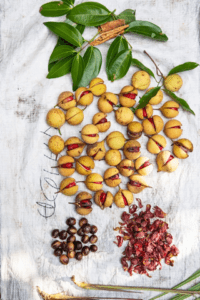
Nutmegs
Half of the population of the archipelago is in Banda Neira, capital, and harbor of the district, which is found on the island of the same name. The inhabitants of Banda Neira descendants of Javanese and Makassar and inhabitants of the neighboring islands brought by the Dutch to work in the Dutch nutmeg plantations. When the Dutch East India Company, the VOC, implanted in the Banda islands and after having chased the Portuguese, drastic decisions had been taken to control and set a strict monopoly on the production and the sale of nutmeg. The indigenous people of the islands were decimated in order to avoid escapes and slaves were put in place.
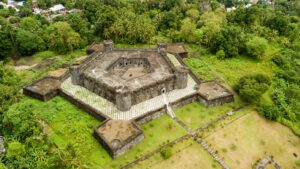
Fort Belgica
Aerial view of a pentagonal fort built by dutch during the spices war in the Banda Neira island, Maluku, Indonesia
The Belgica fort still visible today is what stays from the colonization of the Dutch on the Island. This fort was used for the defense of the Banda islands which at that time, was the only place in the world where we produce nutmeg. Built in 1611 on the order of the Flemish of Belgian origin (hence the name of the fort) Pierter Both, the fort will be renovated and enlarged (supplementary towers to fool the enemy) by Jan Pieterszoon Coen in 1622. The fort has a hexagonal shape, the inside is a vast inside yard which gives access to the ramparts. Cannons are still presents. The access to the top of the towers is done thanks to a ladder. The visit is very pleasant for the walk and the view at the top.
For the Jakaré’s guests, this is an appreciable moment to discover the local population and a flashback to the World History in between numerous beautiful dives.
Diving in the Birds Islands:
Two of the favorite dive sites of our cruise director are around Pulau Manuk and Pulau Suanggi.
The name of those islands come from the thousands birds flying above.
We can indeed admire the Great Frigate birds, some Red footed Boobies, some Brown Boobies and also Lesser Frigate birds, Red-tailed Tropicbird or White-tailed Tropicbirds. Always in movement, flying around and singing, crying, chanting…
The islands seem alive and in motion.
How to name an island in Indonesia?
In 2020, one counted more than 18 000 islands in Indonesia, which all have received a name. So, how do one name an island in Indonesia?
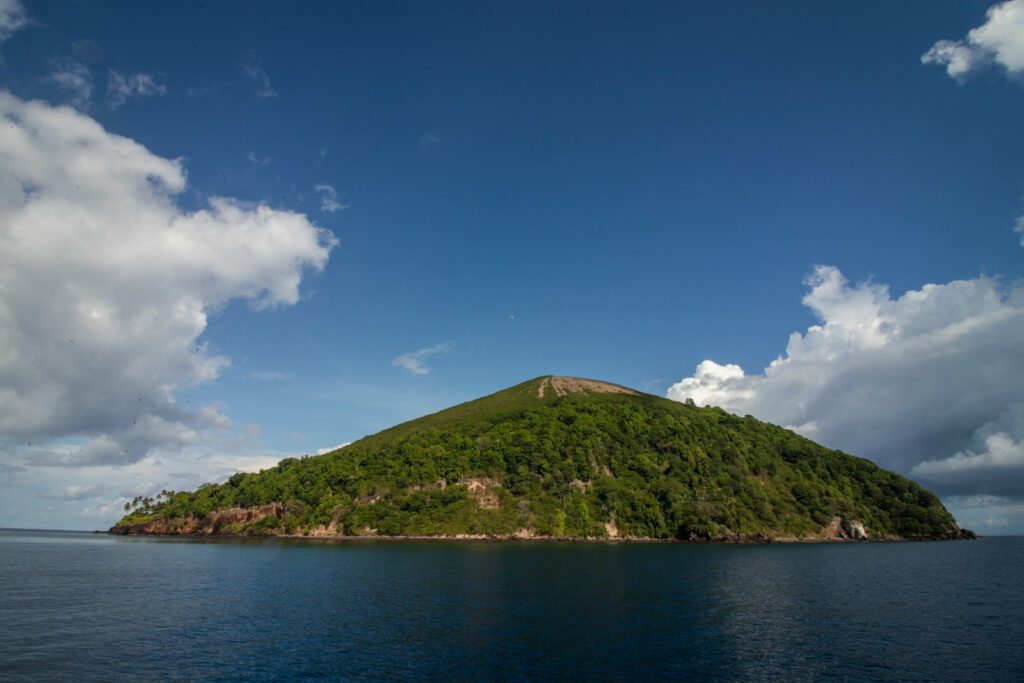
Pulau Manuk
One example with Pulau Manuk:
Manuk means “chicken” or “bird”. So Pulau Manuk literally means birds’ island meanwhile Pulau Manukan (the other name of Suanggi) means the small birds’ island.
According to the local language, Suanggi means “sea ghost”. Its name probably comes from the fact that, from far, only birds can be seen and not the island yet.
Another example is Pulau Pisang:
The crew has a joke on the Jakaré: we say that, on each crossing, the Jakaré will join an island that is named Pulau Pisang or Banana Island because of the banana trees we can see while arriving.
The dives in Pulau Suanggi:
Pulau Suanggi is a stones island, which protect one of the biggest birds’ colonies in Indonesia. The Island and its colony are both protected by the Indonesian government.
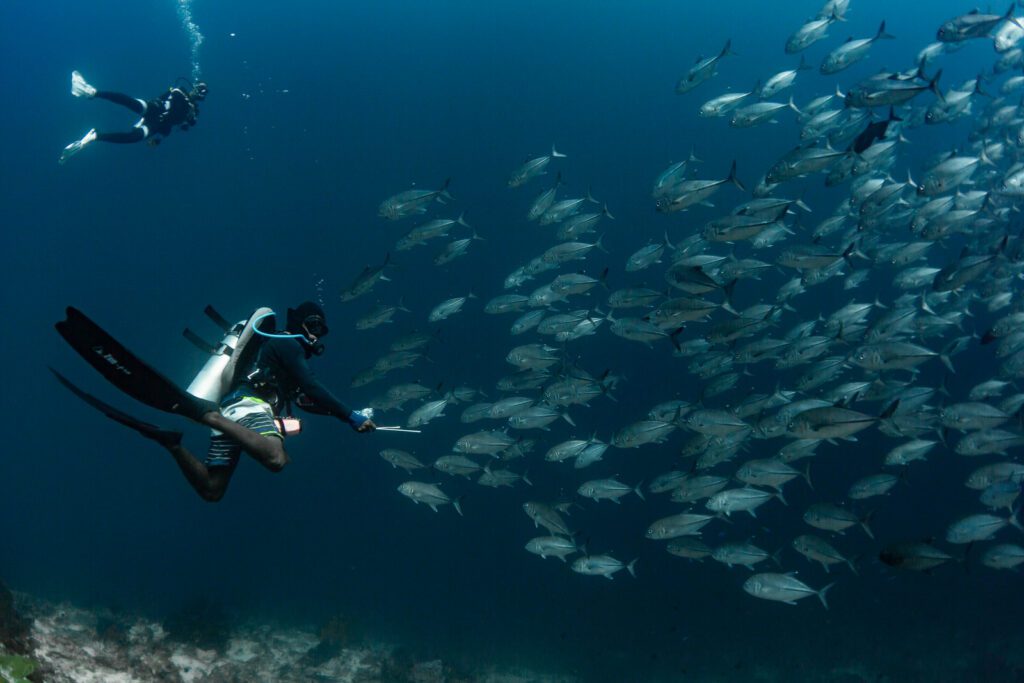
Diving in Pulau Suanggi
The island is located at 3 hours of navigation at the North of Bandaneira. The dives are so incredible that we plan on stopping both on the way to go and on the way back!
The Jakaré does not throw its anchor, first because the island is protected but also because this disturbs the underwater fauna: throwing the anchor scares off the hammerhead sharks.
Conclusion: we spend the day on the way to go and on the way back and we do three dives the two times.
The visibility is simply incredible. Water is crystalline. They are dives with currents in which divers “jump” or “fly” from pinnacle to pinnacle, then they “hide” behind these pinnacles to shelter from the current.
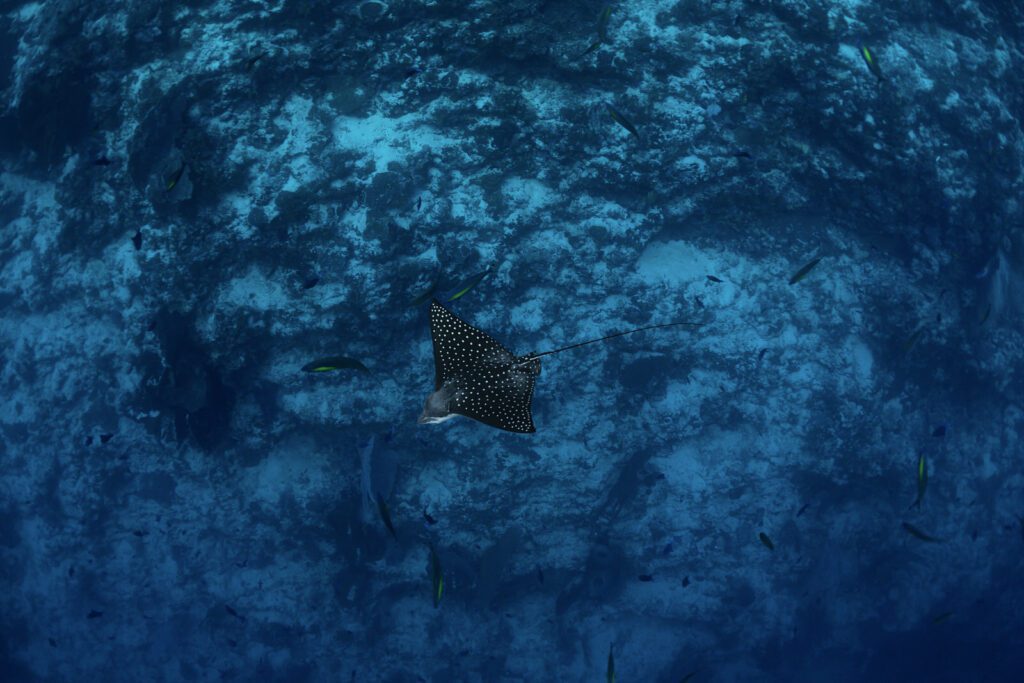
Leopard Ray
The dives take place in the West of the Island. All Suangi is potentially diving but at the West, there is a coral reef with a field of hard coral hills that is unique. Numerous fishes and lot of actions: Giant Trivaly, des Bumphead Parrot fish, Napoleon brass all different types of tuna, mackerel…. They swim, they chase, it bubbles with life. The island is surrounded by a wall and pinnacles that falls to a depth of 40 meters. The continental shelf is not big because really fast the depths reach more than 300 meters.
The waters are hot but not in the famous thermoclines in which hammerhead sharks go back and turn to eat. However, the dives are so pretty that it is worth it even without hammerhead sharks. The corals are amazing and colorful, and they are the proof of the health of the reef. Photographers are always amazed on these dives and bring back pictures with contrast, colors, and a brightness in such.
Despite, these dives are for confirmed divers: dives go down to 35 meters and the way back are at countercurrents, in the blue and potentially passing by thermoclines where it is cold and dark with the eventuality to face a few hammerhead sharks… I let you picture the adrenaline rush.
Dives at Pulau Manuk
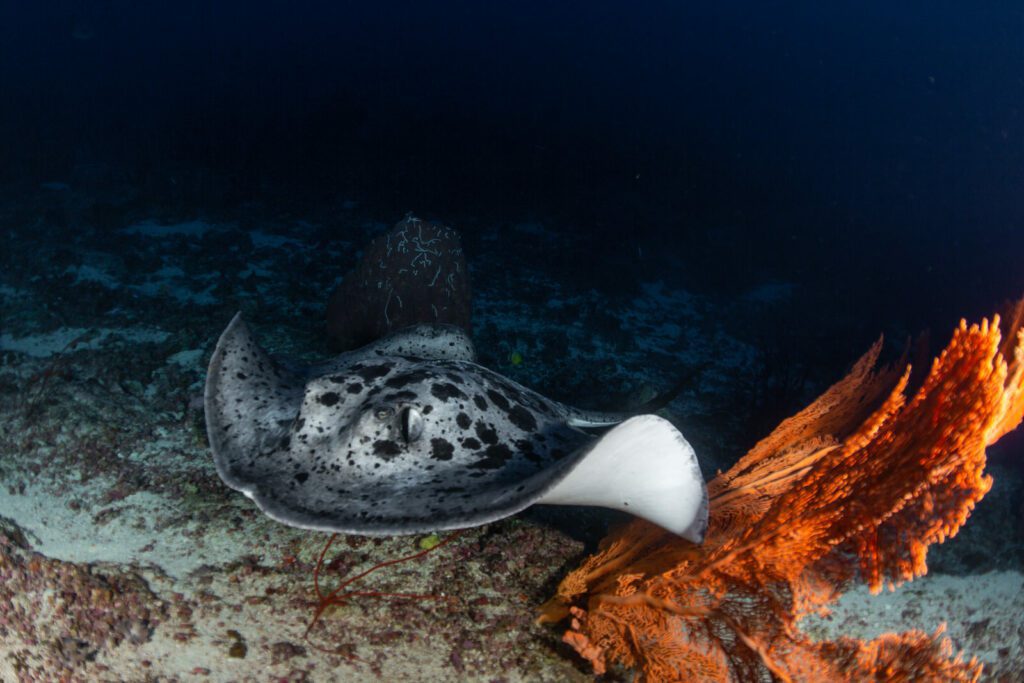
Marbled stingray
“It is insane! It is incredible!” exclaimed our Audrey.
Pulau Manuk is a volcanic island still in activity overflown by thousands of birds and surrounded by beaches, black sandy bottom and schools of barracudas that frolic at the surface and turn their curiosity towards divers, a species not yet well known by the marine inhabitants of Pulau Manuk.
The visibility is just incredible with a pure royal blue. Everything is contrast, nature in its biggest force. Smells do not leave indifferent: there is a mix of sulphur and bird droppings. Nevertheless, once in the water stays only the beauty of the site.
The island is located at almost 10 hours of navigation from the South of Bandeira. All the island’s surroundings are diveable. Audrey has a weakness for Coconut Point: as its name indicates it, it is a point of the island covered by coconuts trees. Under the surface, the diver navigates above numerous ridges underwater with a visibility going up to 50 meters. The water is a deep blue, contrasting with black sand and incredible colors and very diverse like pink, orange and, soft corals. The reef is extremely lively, and waters are rich in nutriments.
In the deep, you can hear and feel the blow and the vivacity of the volcano. This can be impressive.

Sea Snake
Moreover, there are sea snakes… black and white striped knits, fine and small and olive snakes that come from Australia. The latter are brown and green striped, bigger than the striped knitwear, they can reach a meter and a half long and be the thickness of an adult arm. They swim alone or in groups. They are very curious. Although venomous, they are not aggressive and there are very few snake attacks recorded in the world.
Nevertheless, such an encounter makes the diver’s heartbeat faster, and his patience and calmness are put to the test by nature.

Jakare Liveaboard
Our next departures around Banda Sea:
– 8th October 2023 – 15th October 2023
- 7 nights
- Ambon to Ambon
- Private charter or shared voyage
– 18th October 2023 – 28 October 2023
- 9 nights
- Ambon to Ambon
- Private charter or shared voyage
– 30th October 2023 – 10 November 2023
- 11 nights
- Ambon to Sorong
- Private charter or shared voyage
– 3rd November 2024 – 14th November 2024
- 11 nights
- Ambon to Sorong
- Private charter or shared voyage
-
-
– Our Banda Sea cruising rates:
- Private charter from USD 4500 / night
- Cabin from: USD 460 / night / pers

